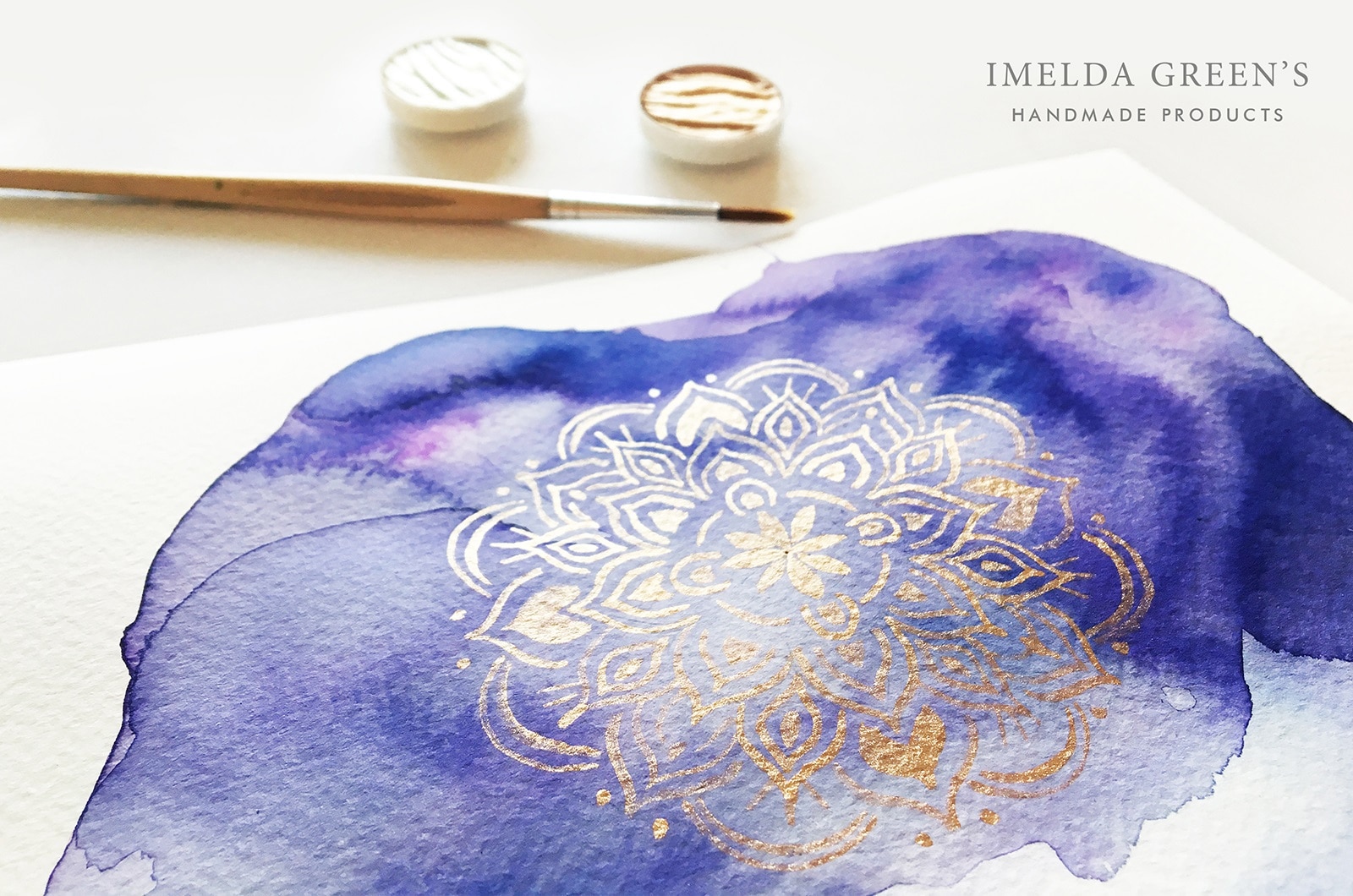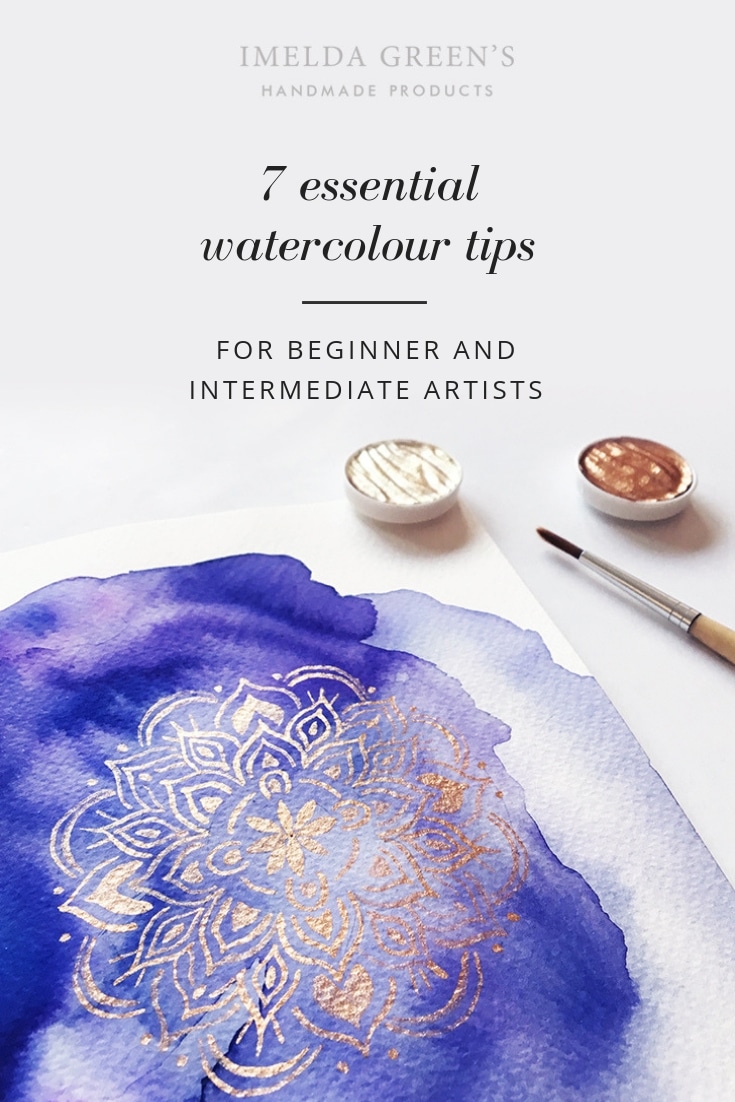
7 watercolour tips for beginners
People often say that watercolour is a hard-to-control medium. However – just like cats :) – watercolour has its own tricks with which you can tame it. After the most common beginner mistakes I’m sharing some tips, which will definitely make watercolour easier for you to practice.
1. Clean your brush properly!
Have you ever tried painting with yellow after applying some dark blue, and turning everything a messy green? I did. Luckily all my torn hair has grown back since, and I have also learned how to clean a brush properly.
Watercolour brushes are specifically designed to hold a lot of water and pigment. This has numerous advantages, but also one disadvantage: it is fairly difficult to remove the pigments from between the hairs. If you dip your brush into water and stir a bit, practically nothing happens. It is much more effective to squish to the bottom of your water container – though it is definitely not good for your brush, because you deform the hairs. So instead, either stir with your brush a couple of times clockwise, then anti-clockwise, or just swirl your brush in infinity shape.
Pro tip: before you try a lighter colour, you can check whether all pigments have been removed from your brush on your paper towel. Does it leave a mark on the white surface?
2. Buy dark/highly pigmented paint
Whether you buy paint colour by colour or in a complete palette, it is always worth choosing dark/highly pigmented paint. Even though you need a bit of practice, you can always lighten watercolour by adding more water – but brightening up dark colours is much more difficult. You can achieve darker colours with less pigmented paint by adding extra layers, but it may not change brightness.
3. Work from light to dark!
One of the difficult things about watercolour is that it is nearly impossible to erase mistakes. As the paint is transparent, you cannot cover your blunders by adding an extra layer. Once you’ve painted something dark, you cannot turn it into light. So it is wise to paint your entire piece in pastel colours first, thinking in advance about the areas you want to keep white. You can later darken the shadows by adding further layers.
Pro tip: if you darken your shadows by extra layers you don’t only prevent mistakes, but also give a beautiful sense of depth to your painting.
4. About the perfect palette…
You cannot learn watercolours without knowing a bit about colour mixing, but where do you actually mix your colours? You can use different things as a palette, but it is best to choose something that does not absorb water/paint – so paper will not do. You can buy professional pallets in art shops, but you don’t necessarily need one of those. You can use a porcelain or plastic plate, or even some left-over tiles. The only important thing is to choose something white, so nothing changes your perception of colour.
Pro tip: don’t wash your palette after use. Watercolour is one of the few mediums that you can 100% re-activate by adding water, even when the paint has dried on your palette. You can save a lot of paint and time by leaving colours on your palette, so you don’t have to mix them again.
5. Test your colours
Some people don’t like mixing colour on plastic surfaces because water shrinks on them, and lack of practice makes it hard for them to see what colour they have created. However, even intermediate watercolourists can run into the problem of not being sure what pigment/water ratio their brush holds. As it’s hard to correct mistakes in watercolour, it is not wise to check your colours on your final painting. It is much better to keep some left-over watercolour paper (or any other paper, for that matter) to test the exact tone of your creation.
6. Do not outline
Watercolourists, who are less experienced or come from a drawing background sometimes start painting a surfcae by outlining the form. However, painting, as a genre, uses surfaces to build up a picture – unlike drawing, which uses linework. This is a particularly important difference if you paint in watercolour, because by the time you start to colour the inside of your shape, the outline will probably have dried. As the paint is transparent, you will not be able to create a solid surface, the outline will remain visible.
You should avoid outlining particularly when painting large surfaces, because the outline will surely dry before you start the inside of your shape. As long as the outline is wet, it will blend smoothly with the inner colour.
7. Be careful with pencil sketches
Depending on the complexity of a piece, many aritsts prefer to create a sketch before starting to paint. Some people use colour pencil or watercolour pencils, others use graffite for this, but all artists keep their sketch very light. Once you paint over your pencil sketch, it is very hard to erase it – even though in my experience, this also depends on the actual brand of the paint. I had no problem erasing graffite sketches from under aniline paint, but it was impossible in the case of Talens art creation watercolor paint. If you choose watercolour pencil, always keep in mind that water will activate the pencil pigments – so if you paint a surface blue that you have outlined in red watercolour pencil, it will probably end up being purple.
Pro tip: if you are unable to crerate light sketches, you should do your sketch on any drawing paper, then transfer the finished sketch lightly on watercolour paper with the help of a light box – or even your window.
These are my top 7 watercolour tips for beginners. If you have any questions, leave a comment or drop me a line, I can hopefully help you out.



Comments (2)
Paddy Guilfoyle
August 14, 2022 at 8:24 pm
Hello Imelda,
I am totally inspired by your negative painting, which I have just found. Thank you for all the helpful advice. I will have a try tomorrow, as it’s a bit late to paint now.
I will be up early to have a go.
Bless you & kind regards,
Paddy
Imelda
August 21, 2022 at 4:15 pm
Thank you so much for your kind words, Paddy! I really hope you’ve had a great time!